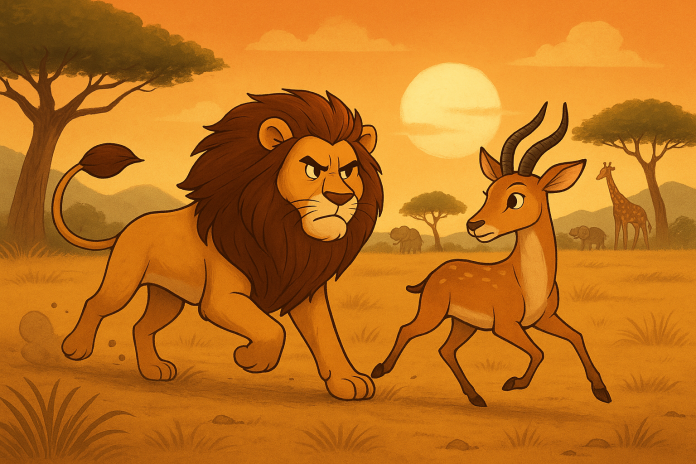In the heart of the great savanna, there lived a majestic lion named Kazi, known far and wide for his strength and speed. He was the ruler of the plains and the pride of all the animals. Every creature, from the smallest meerkat to the tallest giraffe, respected him. Kazi often boasted, “I am the strongest, the fastest, and the smartest. There is no challenge I cannot overcome!”
One day, a young antelope named Zara, who had recently joined the savanna, overheard Kazi’s boastful words. She stood quietly, watching the lion as he strode proudly across the grassland. Zara was small, nimble, and not as fast as the lion, but she had a different kind of strength: patience and wisdom.
“I think I can challenge Kazi to a race,” Zara thought. “But it won’t be about speed. I will use my other strengths.”
The next morning, Zara approached Kazi, who was basking in the sun. “Kazi, I challenge you to a race,” Zara said boldly.
Kazi let out a deep laugh. “You, an antelope, challenging me? Are you sure you’re ready for this? I will finish the race before you even take your first step!”
The animals gathered to watch, and the race began. Kazi sprinted with his powerful legs, his mane flowing in the wind. Zara, however, kept a steady pace, her eyes focused on the horizon. She was determined to use her mind as much as her legs.
As the race continued, Kazi grew further and further ahead. But he had underestimated the power of patience. Zara knew the savanna was vast, and the path was full of challenges. She did not race blindly. Instead, she kept an eye on the clouds above, the wind, and the terrain.
Soon, Kazi, running without any pause, grew tired. The sun beat down harshly, and his muscles began to ache. He slowed down for a moment, panting heavily. “I’ll take a break,” Kazi thought, “The antelope won’t catch up to me.”
Meanwhile, Zara kept her pace steady, avoiding the rocky path and finding shady spots to cool off. She didn’t stop; she only moved wisely.
When Kazi woke up from his rest, he found that Zara had passed him, moving steadily towards the finish line. He roared in disbelief and raced after her, but it was too late. Zara crossed the finish line with a calm, satisfied smile.
Kazi stopped, panting, and realized something important. Zara hadn’t relied solely on speed. She had used her wisdom and patience, understanding the importance of balance in life.
“Well done, Zara,” Kazi said, lowering his head. “You’ve taught me that true strength isn’t just about speed or power, but about knowing when to keep going and when to pause.”
From that day forward, Kazi respected not only the strength of others but also the value of wisdom and patience. And Zara, the humble antelope, became known as the wisest animal in the savanna.
Moral: Strength is not only about speed or power; wisdom and patience can lead to greater victories.
Kids and Health
What are head lice?
Head lice are tiny wingless insects. They live among human hairs and feed on blood from the scalp.
Head lice are a common problem, especially for little kids. But teens can get them too. They spread easily from person to person, and sometimes are tough to get rid of. Their bites can make the scalp itchy and irritated, and scratching can lead to infection.
Head lice are annoying, but they’re not dangerous and they don’t spread disease. They’re not a sign of poor hygiene — head lice need blood and they don’t care whether it’s from someone who’s clean or dirty.
It’s best to treat head lice right away to prevent them from spreading.
What are the signs & symptoms of head lice?
Lice are tiny, but you can still see them — though it’s not always easy. An adult louse is grayish white or tan and about the size of a small sesame seed. Lice move fast, so you’re actually more likely to see their eggs than the lice themselves.
Louse eggs are called nits. Nits look sort of like dandruff, except they don’t brush or fall off as easily as dandruff. Lice attach their nits to pieces of hair, close to the scalp. If you think you have lice and see a small, oval blob on a strand of hair, it’s probably a nit.
If nits are yellow, tan, or brown, it means the lice haven’t hatched yet. If the nits are white or clear, the lice have hatched and just the egg remains. Lice eggs hatch within 1 to 2 weeks after they’re laid.
Besides seeing nits or lice on the head, itching — or the feeling of something moving around on the scalp — is another clue that you might have lice. Like mosquito bites, the itching is a reaction to the saliva of the insect. Some people with lice also get a rash of small red bumps from scratching.
How are head lice treated?
The two main ways to treat lice are: medicine and removing by hand.
Medicine: If you think you have lice, call your doctor. Your doctor can recommend a medicated shampoo, cream rinse, or lotion to kill the lice. These may be over-the-counter (OTC) or prescription treatments. It all depends on what your doctor thinks will work best for you.
Lice can be hard to get rid of. If you still have lice 2 weeks after you started treatment, let your doctor know. Your doctor may want to try a different medication or repeat treatment in case any nits were left behind and hatched after treatment.
Removing by hand: Your doctor may recommend wet combing in addition to (or as an alternative to) chemical treatments. Medicated treatments aren’t 100% effective, so removing by hand is also important.
To remove lice and nits by hand, use a fine-tooth comb on wet, conditioned hair every 3–4 days for 3 weeks after the last live louse was seen. Go through small sections of hair at a time. Wetting the hair temporarily stops the lice from moving, and the conditioner makes it easier to get a comb through the hair. When possible, it works best to have someone else do the combing and removal.
You may have heard that petroleum jelly, mayonnaise, or olive oil can suffocate head lice, but these treatments may not be effective.
How can I prevent head lice?
Lice can be tricky to get rid of because nits can remain unhatched on your head or you might pick up lice that are still on bedding or other items. Here’s what to do if you’ve had lice — or someone in your family has:
Wash bed linens and clothing that anyone with lice has used recently. Use very hot water (130°F [54.4°C]), then use the hot cycle of the dryer for at least 20 minutes.
Take items that can’t be washed to the dry cleaner. Or put them in airtight bags for 2 weeks.
Vacuum carpets and any upholstered furniture, as well as car seats, then throw away the vacuum cleaner bag.
Soak hair-care items like combs, barrettes, hair ties or bands, headbands, and brushes in hot water or just throw them away.
Because lice can move easily from person to person in the same house, family members should be checked for lice. Anyone who has them needs treatment.
Did you know?
1. Honey never spoils — archaeologists have found 3,000-year-old pots of it in Egyptian tombs.
2. Nigeria has over 500 languages spoken across the country.
3. Cows can walk up stairs but not down them.
4. The Yoruba talking drum can mimic human speech.
5. Water makes up about 70% of the human body.
6. The largest market in West Africa is Onitsha Main Market.
7. Lightning is five times hotter than the surface of the sun
Riddles
1. What has hands but can’t clap?
2. What has a head and a tail but no body?
3. What has cities, but no houses; forests, but no trees; and rivers, but no water?
4. I speak without a mouth and hear without ears. I have no body, but I come alive with the wind. What am I?
5. What can you catch but not throw?
6. If you have me, you want to share me. If you share me, you don’t have me. What am I?
7. What has four wheels and flies?
Answers
1. A clock 2. A coin 3. A map 4. An echo 5. A cold 6. A secret 7. A garbage truck



